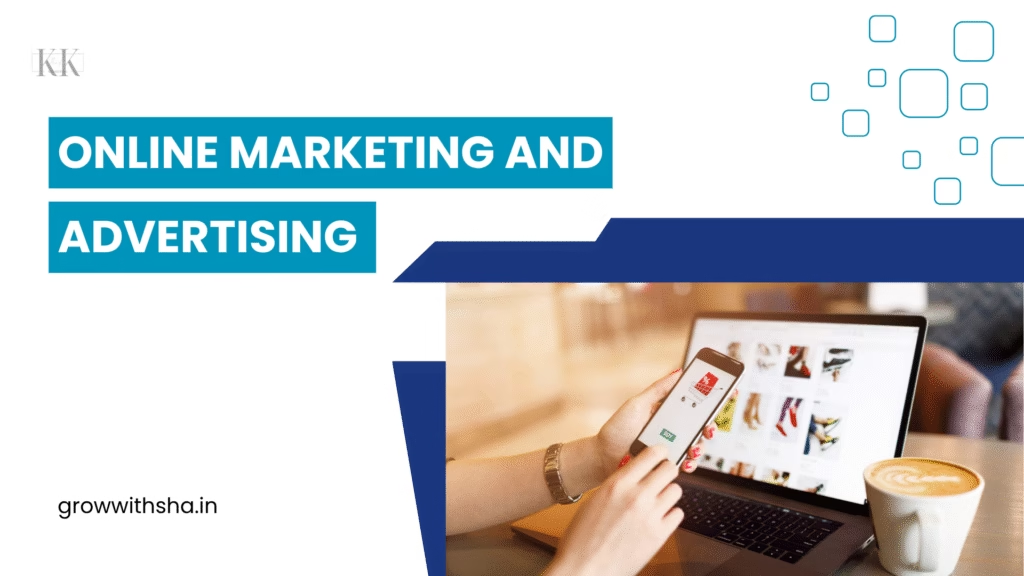In today’s rapidly evolving digital landscape, online marketing and advertising have become indispensable for businesses, making them crucial for sustained success. Whether you’re a small start-up looking to expand your reach or an established brand trying to stay ahead of competitors, mastering the art of online marketing is essential. The digital landscape has rapidly evolved in recent years, making traditional methods of marketing less effective and opening up new opportunities for advertisers. From social media to search engines, the internet offers a variety of platforms and tools that help businesses connect with their target audiences in real-time.
As the world becomes more digitally connected, consumers are spending more time online, interacting with brands through their devices, social media, and websites. This constant digital presence presents a unique opportunity for businesses to engage with potential customers. The key is to have a well-rounded approach to online marketing and advertising that incorporates multiple strategies, platforms, and tools. With the constant emergence of new trends and technologies, online marketing has become more complex but also more effective, allowing businesses to reach highly targeted audiences in ways never before possible.
This comprehensive guide will explore the core strategies, tools, and emerging trends in online marketing and advertising, providing you with the knowledge you need to succeed in this ever-evolving digital landscape. Whether you’re a seasoned marketer or just starting, you’ll find actionable insights to elevate your online marketing efforts and drive measurable results for your business.
Understanding Online Marketing and Advertising

Online marketing and advertising refer to the use of digital channels to promote products or services to a targeted audience. Unlike traditional marketing methods, online marketing enables businesses to reach a global audience in real-time, utilizing the internet’s vast array of platforms, tools, and technologies. This marketing approach leverages a combination of organic and paid tactics to drive traffic, engage users, and convert prospects into customers.
The key distinction between online marketing and traditional marketing is the platform through which they reach the audience. While traditional marketing relies on physical materials such as TV ads, billboards, or print media, online marketing takes place primarily on the internet. It spans across various digital platforms, including search engines, social media, email, and display ads, providing businesses with an endless array of options to reach their target customers. This shift to the digital space has revolutionized the way businesses approach online marketing and advertising.
Key components of online marketing include:
- Search Engine Marketing (SEM): Using paid ads on search engines like Google to reach people searching for products/services related to your business.
- Content Marketing: Creating valuable and relevant content that attracts, informs, and engages customers.
- Social Media Marketing: Using platforms like Facebook, Instagram, LinkedIn, and Twitter to interact with and engage users.
- Email Marketing: Sending personalized messages to individuals on your email list to drive engagement and conversions.
- Display Advertising: Using banner ads, video ads, and interactive formats to catch the attention of users on websites.
- Affiliate Marketing: Partnering with affiliates to promote your products/services and paying them a commission for each lead or sale generated.
At its core, online marketing and advertising are about understanding your audience and delivering personalized messages across various digital channels. Digital advertising, a subset of online marketing, involves the paid aspect of reaching potential customers through platforms like Google Ads, Facebook Ads, and more. Online marketing and advertising strategies encompass a range of tactics, including content marketing, SEO, email campaigns, and social media promotions, each serving a distinct purpose in driving traffic, engagement, and conversions.
Core Strategies in Online Marketing
Online marketing and advertising aren’t just about promoting products—they’re about building lasting relationships with your target audience through consistent engagement, valuable content, and personalized experiences. In the realm of online marketing and advertising, it’s essential to understand your audience’s needs and preferences to deliver messages that resonate. This approach fosters trust and loyalty, leading to long-term success.
Search Engine Optimization (SEO)
SEO is a fundamental aspect of online marketing and advertising, focusing on enhancing a website’s visibility on search engine results pages (SERPs). By optimizing digital content, businesses ensure that their offerings appear prominently when users search for relevant keywords. This is crucial because a significant majority of users tend to click on the top results, making SEO a vital component of any successful online marketing and advertising strategy.
A solid SEO strategy includes the following components:
- Keyword Research: Identifying the most relevant keywords your target audience is searching for.
- On-Page Optimization: Optimizing elements like titles, meta descriptions, headers, and content for search engines.
- Off-Page Optimization: Building backlinks from authoritative websites to improve your site’s credibility.
- Technical SEO: Enhancing the backend of your site, such as improving site speed, ensuring mobile optimization, and using HTTPS for secure browsing.
- Local SEO: Optimizing your online presence for location-based searches, such as “restaurants near me.”
Why is SEO important?
- Increased organic traffic: Higher search rankings lead to more visits from potential customers.
- Cost-effective: Unlike paid advertising, SEO drives organic visitors to your site without continuous expenses, delivering long-term benefits.
- Better user experience: Optimizing for mobile and fast-loading pages enhances user satisfaction and retention.
- Long-term ROI: Although SEO takes time to show results, it has lasting effects and continues to deliver organic traffic.
Effective SEO helps drive organic traffic to your website, making it an essential component of long-term online marketing and advertising success. SEO is an ongoing process that requires constant monitoring, adjustments, and optimization based on performance data.
Content Marketing
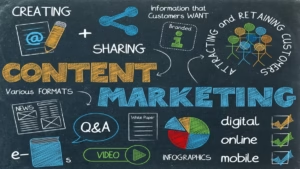
Content marketing is a cornerstone of online marketing and advertising, focusing on creating and sharing valuable, relevant, and consistent material to attract and retain the attention of your target audience. This strategy goes beyond just selling a product or service; it’s about providing value, educating your audience, and establishing your brand as a trusted authority in your industry.
Core components of a powerful content marketing strategy include:
- Content Creation: Developing various forms of content, including blog posts, videos, podcasts, and infographics.
- Audience Engagement: Developing content that aligns with the needs and preferences of your target audience.
- Content Distribution: Sharing content across multiple channels (e.g., social media, email newsletters, guest posts) to increase reach.
- Content Optimization: Making sure the content is optimized for SEO to enhance its potential for ranking higher in search results.
- Storytelling: Using compelling narratives that engage users emotionally and encourage interaction.
Types of content that work well:
- Blog posts and articles that provide useful, well-researched information.
- Videos that break down complicated subjects into clear, engaging, and easily digestible formats.
- Visual infographics that simplify complex data for quick and easy understanding.
- Real-world case studies that highlight tangible outcomes and experiences, strengthening trust and authority.
An effective content marketing approach within online marketing and advertising centres on identifying and addressing the specific interests and requirements of your intended audience. By addressing these needs with high-quality content, you can build trust, increase engagement, and drive traffic to your website. Additionally, content marketing plays a crucial role in SEO by improving your site’s relevance and authority, which can help boost your rankings on search engines.
Email Marketing
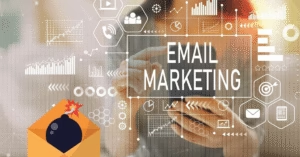
Email marketing, a vital component of online marketing and advertising, offers a personalized and direct approach to connect with existing customers and prospective clients. It allows businesses to communicate valuable offers, product updates, and promotions directly to users’ inboxes.
Essential elements of effective email marketing include:
- Personalization: Tailoring emails to individual preferences based on past interactions, demographics, or behaviour.
- Segmentation: Grouping your audience into segments to deliver more relevant content and offers.
- Automation: Setting up automated email sequences to nurture leads, welcome new subscribers, or follow up on abandoned carts.
- A/B Testing: Testing different subject lines, email content, and designs to determine what resonates best with your audience.
- Mobile Optimization: Ensuring your emails are mobile-friendly to accommodate the growing number of mobile email users.
Why email marketing works:
- Direct communication: It’s a personal, one-on-one channel for engaging your audience.
- Highly targeted: Segmenting your list allows you to send highly relevant offers and content.
- Measurable results: Analytics help track open rates, click-through rates, and conversion rates for continuous optimization.
- Low cost, high ROI: Email marketing stands out as a highly economical channel that delivers substantial return on investment.
Email marketing, when executed properly, helps nurture relationships, drive conversions, and maintain brand loyalty. With personalized messages and well-timed campaigns, email marketing can generate a high ROI for businesses.
Advanced Online Marketing Techniques
While mastering the fundamentals of online marketing and advertising is essential, utilizing advanced techniques can significantly elevate your digital efforts. These strategies offer businesses a competitive advantage, allowing them to stand out in the competitive online environment. Below are some advanced methods that successful marketers are using to boost efficiency, engagement, and conversions.
1. Artificial Intelligence (AI) and Automation
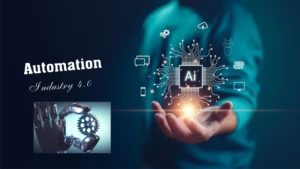
AI is reshaping online marketing and advertising by enabling smarter, more efficient campaigns. From predictive analytics to creating personalized user experiences, AI equips businesses with tools to engage their audience more effectively.
Applications of AI in Digital Marketing:
- Chatbots: AI-powered chatbots offer immediate customer support, assist with common queries, and guide users throughout their journey, increasing engagement and satisfaction.
- Predictive Analytics: AI systems analyse customer data to predict future actions, enabling marketers to tailor campaigns with higher accuracy.
- Personalization at Scale: AI automates personalized content and product suggestions across various platforms, enhancing the customer experience.
- AI in Content Creation: Tools like GPT-3 assist in generating tailored content ideas, writing blog posts, or creating compelling ad copy.
Benefits of AI in Marketing:
- Increased Efficiency: AI automates routine tasks, freeing up time for more strategic decision-making.
- Better Decision-Making: Real-time data-driven insights enable marketers to adjust campaigns on the fly.
- Enhanced Customer Experience: AI can personalize communication and content dynamically, making interactions more relevant and engaging.
2. Influencer Marketing

Influencer marketing is a dynamic component of online marketing and advertising, involving collaborations with social media personalities who have large, engaged followings to promote products or services.
Why Influencer Marketing Works:
- Trust and Credibility: Influencers have built trust with their audience, making their endorsements more influential than traditional ads.
- Targeted Reach: Working with influencers allows brands to access specific audiences that align closely with their products or services.
- Authenticity: Influencers are perceived as relatable and trustworthy, lending authenticity to marketing messages.
Types of Influencer Collaborations:
- Sponsored Posts: Influencers create content that promotes your product for a fee.
- Affiliate Marketing: Influencers earn commissions based on sales generated through their referral links.
- Giveaways and Contests: Partnering with influencers to organize giveaways or contests that engage their followers and increase exposure.
Benefits of Influencer Marketing:
- Boosted Brand Visibility: Influencers introduce your brand to their followers, increasing traffic and recognition.
- Increased Brand Trust: Collaborating with well-known influencers builds credibility among their audiences.
- Higher Engagement: Influencer content tends to garner higher interaction rates, leading to more conversions.
3. Video Marketing
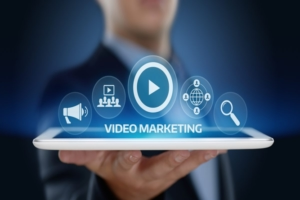
Video marketing remains one of the most powerful tools in online marketing and advertising. With platforms like YouTube, TikTok, and Instagram gaining massive traction, video content is now a critical component of any successful marketing strategy.
Types of Video Content:
- How-To Guides and Tutorials: Offering instructional content related to your products or services provides value to your audience.
- Product Demos: Showcasing how your product works or highlighting its key features can drive interest and conversions
- Behind-the-Scenes: Offering an insider’s view of your company builds transparency and trust with your audience.
- Customer Testimonials: Sharing authentic reviews and experiences from real customers strengthens your brand’s credibility.
- Live Streaming: Engage your audience in real-time through live sessions, product launches, or Q&A.
Why Video Marketing is Effective:
- Highly Engaging: Video content captures attention quickly and holds viewers’ interest.
- Higher Conversion Rates: Including video on landing pages significantly boosts conversion rates.
- SEO Benefits: Well-optimized video content can enhance your visibility on search engines, attracting increased organic traffic to your site.
4. Retargeting and Remarketing
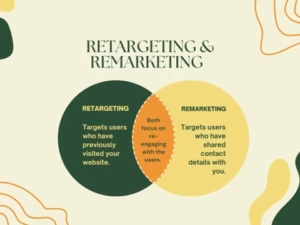
Retargeting and remarketing are powerful techniques within online marketing and advertising that aim to re-engage users who have interacted with your brand but haven’t made a purchase or conversion yet.
How Retargeting and Remarketing Work:
- Retargeting Ads: These ads target users who visited your website but didn’t make a purchase. The ads follow users across other platforms, increasing the likelihood of conversion.
- Remarketing Emails: Engaging users who abandoned their shopping cart or showed interest in a product without purchasing, often offering discounts or incentives to complete their transaction.
Benefits of Retargeting and Remarketing:
- Higher Conversion Rates: Users who have interacted with your brand previously are more likely to convert.
- Cost-Effective: Retargeting is more affordable than acquiring new customers, as you’re focusing on individuals already familiar with your brand.
- Improved Brand Recall: Continuous interaction through retargeting reinforces brand awareness, influencing future purchase decisions.
5. Voice Search Optimization

As voice-activated devices like Amazon Alexa and Google Assistant become more widespread, optimizing for voice search is becoming an essential strategy in online marketing and advertising.
Tips for Optimizing for Voice Search:
- Natural Language: Voice queries are more conversational. Concentrate on refining your content for specific, longer keyword phrases and queries.
- Local SEO: A large number of voice searches are focused on local queries (e.g., “What’s the closest coffee shop?”), therefore, it’s essential to tailor your business for location-specific search outcomes.
- Featured Snippets: Voice assistants typically extract information from featured snippets, so it’s important to format your content clearly and succinctly to be included in these responses.
Benefits of Voice Search Optimization:
- Better Visibility: Optimizing for voice search increases the likelihood of appearing in voice search results.
- Improved User Experience: Voice search offers fast, hands-free answers, enhancing the overall user experience.
- Boosted Organic Traffic: Brands that appear in voice search results often see a significant rise in website visits and engagement.
Conclusion
In today’s digital-first world, mastering online marketing and advertising is not just an option—it’s a necessity. From SEO and content marketing to email campaigns and social media advertising, the digital marketing landscape offers endless opportunities for businesses to grow and succeed. By understanding the core strategies and leveraging the right tools, you can create a comprehensive marketing plan that drives targeted traffic, builds brand awareness, and ultimately converts leads into loyal customers.
The key to success lies in continuous learning, adaptability, and staying ahead of emerging trends. As technology continues to evolve, businesses must embrace new tools and tactics to ensure they remain competitive in an ever-changing market. Whether it’s optimizing your website for search engines, creating engaging content, or launching targeted ad campaigns, every effort you make in online marketing and advertising will contribute to your overall success in the digital world.
Online marketing and advertising are not just about pushing products or services—they’re about creating meaningful relationships with your audience, delivering value, and providing a seamless customer experience across multiple digital touchpoints. By combining creativity with data-driven insights, businesses can maximize their reach, increase conversions, and achieve long-term growth.
As technology continues to evolve, it’s essential to adopt the latest strategies and tools to stay competitive. With the right approach, businesses can create highly personalized, effective campaigns that resonate with their audience and drive results.
By leveraging the power of AI, optimizing for voice search, and employing the right marketing strategies, businesses can unlock new opportunities, grow their online presence, and achieve long-term success. Staying informed, adaptable, and data-driven will help businesses thrive in the ever-evolving online marketing and advertising landscape.
Author: Shafna K.K.

